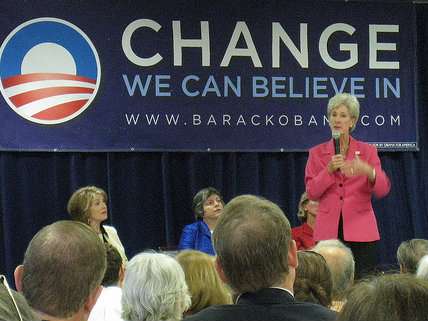Obamacare's Website Is Working (Somewhat) Better—But It's Still Going To Have a Tough Time Hitting Its Sign-Up Goals

Funny how quickly Obamacare data leaks when it's reasonably good news. During the initial days of Obamacare's launch, federal officials repeatedly refused to provide enrollment data. Health and Human Services Secretary Kathleen Sebelius and Press Secretary Jay Carney even claimed they didn't have.
Leaked notes from the administration's Obamacare "war room" later revealed that just six people made it all the way through the federal exchange system, which covers 36 states, on day one. And despite the denials from administration officials, the low number was known and discussed inside parts of the administration by the second morning the exchanges were online. Eventually we found out that during the entire month of October, just 27,000 people signed up for health insurance plans through HealthCare.gov—a figure that the administration waited until the middle of November to release.
But now that the consumer end of the federally run insurance portal is working somewhat better, sign-up data is leaking on a daily basis. In the last three days alone, some 56,000 people have picked plans through the site, including about 27,000 on Tuesday alone, according to a report in The Washington Post citing sources familiar with the numbers.
Working "better" is, of course, a pretty low bar, since the federal insurance portal was barely working at all for the month of October. But there's no question that this represents a meaningful improvement in site performance, at least on the consumer side.
Yet these numbers don't necessarily point to success for the law. For one thing, it's not certain that all of the people being counted in these tallies will actually be enrolled. As The Hill noted yesterday when the first two days of sign-up numbers leaked, these enrollees are "people who chose plans but had not necessarily paid their first premium." The (likely administration-connected) sources tipping reporters to these numbers say the administration is counting these individuals as having enrolled. But as a CNN story today points out, no one is actually enrolled without paying the first month's premium. According that story, one insurer in Indiana has recieved payment from just 20 percent of applicants. So these numbers may be overstating the true enrollment levels within the federal exchange system.
Nor does this take into account the ongoing problems with transmitting accurate enrollment information to insurers. Sources told The Washington Post earlier this week that roughly a third of enrollments were affected by these errors. Insurers say that in some cases, enrollment data isn't being transmitted at all.
Even if you assume that everyone ends up enrolled, the current trajectory probably doesn't put the administration on track to hitting its goal of enrolling seven million people in private coverage through the law by the end of March.
At an average of about 19,000 sign-ups per day, the result would be about 2.3 million enrollments in the federal system. State-run exchanges will add to that total, but not enough to get it close to the goal: California, the biggest of the states running its own exchange, is only aiming to get 500,000-700,000 individuals signed up by the end of March, and most of the other states are relatively small.
Of course, enrollment almost certainly won't proceed on an evenly distributed basis. The experience of Massachusetts with Romneycare suggests that there will probably be a significant spike in enrollment right before the individual mandate kicks in, although the enrollment numbers there are so low, relatively speaking—just over 8,000 people enrolled in the final month before the mandate kicked in—that it's hard to draw a strong conclusion about how much the Bay State's enrollment patterns will be replicated on the much larger national scale.
I would also expect that there's a (smaller) surge of activity during the early part of this month. The website is finally performing well enough to be usable for many people; December 23 is the (revised) deadline to get coverage that kicks in on January 1; and Medicare private exchanges typically experience a spike in enrollment during the week after Thanksgiving. My best guess, then, is that we'll see somewhat higher sign-up activity this month, slightly lower numbers in January and February, and a big jump in March. But since nothing on this scale has ever been tried before in the U.S., no one really knows. But the point is that the administration will need to significantly boost the average number of sign-ups in order to meet their enrollment target.
Finally, it's worth remembering that the headline enrollment total, whatever it turns out to be, isn't the only number that matters. As the administration has indicated repeatedly, it's also important that health plans manage to sign up the right demographic mix, with enough young and healthy individuals to balance out the older and sicker beneficiaries. Already, there are signs that young adults are may spurn the law and its coverage scheme, with more than half of young adults aged 18-29 disapproving of the law, believing it will make their care more expensive, and saying they are unlikely to enroll in coverage.
The administration, meanwhile, hasn't released demographic breakdowns of people who have signed up so far, which is telling enough. Since enrollees have to provide their age and other personal information, we know that the data on the demographic composition of sign-ups so far exists. And since we also know that good news leaks, and bad news doesn't, it's probably safe to assume that whatever information the administration has isn't particularly good.


Show Comments (96)